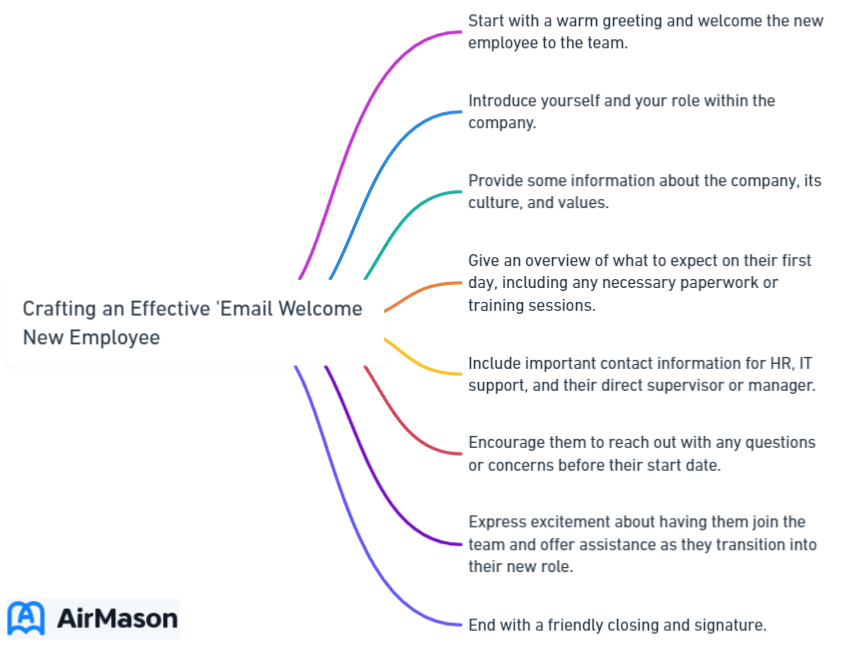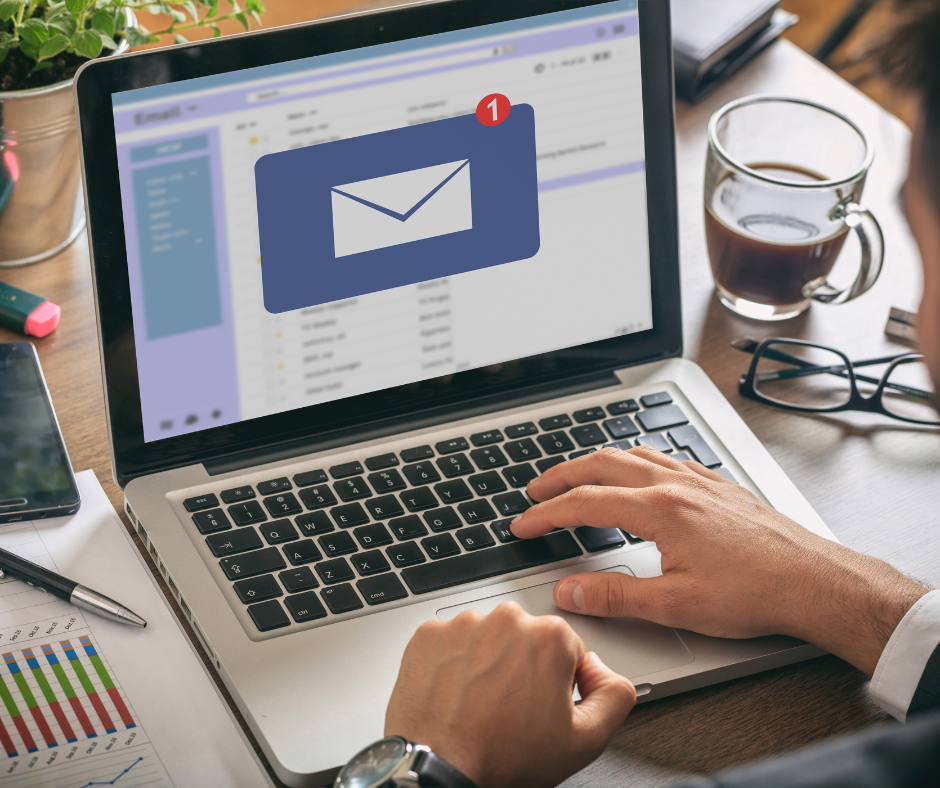
In 2024, the workplace continues to evolve, and welcoming new employees has never been more important. Crafting an effective “Email Welcome New Employee” can make all the difference in setting the right tone for a successful onboarding experience. But how can you ensure your welcome email stands out and leaves a lasting impression?
Fear not, as this blog post will guide you through the essential components of creating an engaging welcome email, tailored to various work environments and striking the perfect balance between casual and professional tones. Let’s dive in and explore the art of crafting a memorable welcome email for your newest team members!
Key Takeaways
- Welcome emails are a critical tool for successful onboarding, particularly for remote employees.
- Effective welcome emails should include personalized greetings, company culture and values, as well as onboarding details to suit different work environments.
- Timing is key to ensure success. Email tracking tools can help analyze effectiveness while avoiding generic content and insufficient information is essential in crafting an engaging message.
The Importance of a New Employee Welcome Email
A new employee welcome email serves as a pivotal tool in establishing a positive first impression, promoting a sense of belonging, and setting the groundwork for a successful onboarding experience. It’s your chance to make the new employee feel like a valuable asset to the company and provide them with the crucial information they need to hit the ground running.
Further, a well-structured welcome email can put remote employees at ease, familiarizing them with the company’s processes and culture, which ensures a warm and prepared welcome on their first day. Thus, the influence of a well-constructed welcome email is undeniably significant.

Welcome to the Team
We are thrilled to extend a warm “welcome in the team” to you! Your arrival marks an exciting milestone for us, as we believe your unique skills and talents will be invaluable in achieving our collective goals. Joining this dynamic group means becoming part of a community that values collaboration, creativity, and a shared commitment to excellence. As you settle in, rest assured that you have a dedicated support system in place, ready to assist you in any way possible. We encourage you to bring your fresh perspectives and innovative ideas to the table, as they will undoubtedly contribute to the continued success of our team. Once again, “welcome in the team” – we’re eager to embark on this journey together!
Essential Components for a Successful Welcome Email

Creating a memorable new employee welcome email involves considering three key components: personalized greetings, company culture and values, and onboarding details. These elements, when combined, will help the new employee feel like an important addition to the team from day one.
We’ll now examine each of these components to appreciate their significance.
Personalized Greetings
First impressions are everything, and personalized greetings play a crucial role in fostering a welcoming environment for the new employee. Including the employee’s name and acknowledging their unique skills or qualifications in the greeting demonstrates that their contributions are appreciated and valued.
Not only do personalized greetings set a warm and amicable tone, but they also contribute to employee engagement by fostering trust, belonging, and intimacy. Addressing the individual’s specific needs and interests makes employees feel valued and appreciated, resulting in increased job satisfaction and enhanced performance.
Company Culture and Values
Sharing the company culture and values in the welcome email is essential for setting expectations and ensuring the new employee understands the organization’s objectives and priorities. Expressing enthusiasm and providing information about the mission and values cultivates an inclusive atmosphere that aids the new employee in feeling connected to their colleagues.
In addition, consider mentioning team-building activities, such as a team lunch, to further strengthen the bond between the new employee and their colleagues. By emphasizing company culture and values, you pave the way for a smooth transition and a strong sense of belonging within the team.
Onboarding Details
Providing onboarding details in the welcome email is vital to equip the new employee with necessary information and resources for their first day. This may include contact information for the new hire’s direct manager or hiring manager, who can offer further guidance and support.
Offering a comprehensive overview of the onboarding schedule, inclusive of the first-day itinerary, key contacts, and team dynamics, guarantees the new employee arrives well-prepared and welcomed. This attention to detail in the onboarding process can make all the difference in setting the stage for a successful start at the company.
Crafting a Welcome Email for Different Work Environments

Given the dynamic nature of work environments, tailoring your welcome email to fit the specific needs of in-person, remote, and hybrid workplaces is a necessity. By addressing the unique challenges and opportunities presented by each work environment, you can create a welcome email that resonates with the new employee and sets them up for success.
We’ll now examine the process of crafting welcome emails for these diverse work environments.
In-Person Workplace
For in-person workplaces, your welcome email should focus on office logistics, introductions, and first-day activities. Providing information about the office layout, essential facilities, and any necessary equipment or tools can help new employees navigate the physical workspace with ease.
In addition, organizing team icebreakers, office tours, and festive first-day activities can create a positive first impression and help the new employee feel welcomed and engaged from the start. By addressing the unique aspects of in-person workplaces in your welcome email, you can ensure a smooth onboarding experience for your new hire.
Remote Employees
When crafting a welcome email for remote employees, it’s crucial to emphasize the following:
- Virtual communication tools
- Remote onboarding processes
- Specific details about internal communication technology
- Any logistical information required to set up their virtual workspace
To support relationship-building among remote employees, consider granting them access to virtual team-building activities and encouraging them to participate in online forums or virtual networking events. By addressing the unique challenges faced by a remote employee, your welcome email can help them feel connected and engaged, even from a distance.
Hybrid Workspaces
Hybrid workspaces combine both physical and virtual elements, and your welcome email should address both aspects to ensure a seamless onboarding experience. Start by introducing the hybrid work environment and highlighting the advantages of the hybrid model. Provide information on in-person and remote aspects, and offer support and resources to help the new employee navigate this unique work setting.
By catering to both in-person and remote elements in your welcome email, you provide clear guidance on expectations, helping the new employee feel confident and prepared for their role in a hybrid workspace.
Announce New Employee
We are thrilled to announce a new employee to our team! Starting today, [Employee Name] will be joining us as [Position]. With [his/her] extensive experience in [relevant field or industry], [Employee Name] brings a wealth of knowledge and a fresh perspective to our organization. We believe that [his/her] skills and expertise will greatly contribute to our continued success. Please join us in welcoming [Employee Name] to the team, and take a moment to introduce yourselves and extend a warm greeting. We are confident that [he/she] will quickly become an invaluable asset to our company, and we look forward to the positive impact [he/she] will have on our projects and team dynamics.
Examples of Effective New Employee Welcome Emails

Having covered the vital components of a successful welcome email and its adaptation for various work environments, we’ll now review some examples of effective new employee welcome emails.
These examples will showcase different tones and focuses, such as casual, professional, and team introductions, to help you craft the perfect welcome email for your organization.
Casual Tone
A casual tone welcome email can create a friendly atmosphere, helping new hires feel a warm welcome and become part of the team from the outset. To achieve this, use phrases such as ‘Hey there!’ or ‘Hi friend!’ in your greeting, and maintain a light-hearted, informal tone throughout the email.
While a casual tone can create a warm and welcoming environment, it’s essential to strike a balance between being approachable and maintaining professionalism. Remember, the goal is to make the new employee feel comfortable and valued, while still conveying the organization’s expectations and priorities.
Professional Tone
A professional tone welcome email is an excellent choice for organizations that want to convey their expectations and emphasize the new employee’s skills and experience right from the beginning. To create a professional tone, use formal language and maintain a respectful, courteous demeanor throughout the email.
In your welcome email, introduce the new employee by mentioning their name, job title, and a brief summary of their professional background. Highlight any notable achievements or experiences that make them a valuable addition to the team, expressing excitement and enthusiasm about having them join the company name. Don’t forget to include the new employee’s contact information, so everyone can easily reach out and welcome them personally.
Team Introduction
A team introduction welcome email can help new hires feel connected to their colleagues and encourage relationship-building from day one. To create a successful team introduction, provide an overview of the entire team, including names, job titles, and brief descriptions of their roles and responsibilities. As you introduce the new team member, make sure to extend a warm “welcome to the team” in your email.
Additionally, consider organizing welcome events or activities that allow the new employee to meet and engage with their new colleagues. This could include team lunches, coffee breaks, or team-building exercises. By fostering a sense of camaraderie and connection, a team introduction welcome email can set the stage for a successful onboarding experience.
Now Run Teamworks
In the realm of collaborative endeavors, the phrase “now run teamworks” encapsulates the essence of effective teamwork. It serves as a call to action, urging individuals to synchronize their efforts seamlessly towards a common goal. Successful teamworks hinge on clear communication, shared objectives, and a collective commitment to excellence. Each member plays a pivotal role, leveraging their unique strengths and skills to contribute to the team’s success. It’s crucial to foster an environment of trust and mutual respect, allowing team members to express their ideas and concerns freely. By embracing the mantra of “now run teamworks,” teams can navigate challenges, adapt to dynamic circumstances, and achieve remarkable outcomes that surpass individual efforts.
Tips for Sending and Tracking Your Welcome Email

The act of sending and monitoring your welcome email is a key aspect of the onboarding process, guaranteeing the new employee receives all necessary information for success.
In the ensuing sections, we’ll provide tips on optimal timing for your welcome email and the use of email tracking tools to oversee engagement and ensure prompt delivery.
Timing

Timing is essential when sending a new employee welcome email, as it can significantly impact the new hire’s perception of the organization and their onboarding experience. It’s recommended to send the welcome email after the job offer has been accepted and before the first day, as this ensures the onboarding process is initiated before their official start date.
Moreover, sending the welcome email one or two days before the employee’s first day can help them feel more prepared and welcomed during their first few weeks. By carefully considering the timing of your welcome email, you can create a positive first impression and ensure a smooth onboarding process for your new employee.
Email Tracking Tools
Utilizing email tracking tools to monitor engagement can offer valuable insights into the effectiveness of your welcome email and help identify areas for improvement. Popular email tracking tools, such as ContactMonkey, can provide metrics on open rates, click-through rates, and engagement with specific links or attachments within the email.
By analyzing these metrics, you can optimize your welcome email to better engage new employees and ensure they receive the necessary information. Additionally, email tracking tools can help identify recipients who have not opened or engaged with the email, allowing you to follow up and ensure they receive the support they need.
Welcome Email Mistakes to Avoid

While crafting your welcome email, avoiding common missteps that can compromise its effectiveness is vital. Some mistakes to avoid include being too generic, providing insufficient information, or neglecting to follow up.
A generic welcome email can cause confusion and dissatisfaction, as the new employee may not feel valued or appreciated. On the other hand, failing to follow up after sending a welcome email can result in low engagement and a negative impression of the sender.
By being mindful of these mistakes and focusing on personalization, clarity, and engagement, you can create a welcome email that sets your new employee up for success.
Summary
In conclusion, crafting an effective new employee welcome email is a vital aspect of the onboarding process. A well-thought-out welcome email can create a positive first impression, foster a sense of belonging, and provide essential information to ensure a successful onboarding experience.
By considering the unique needs of different work environments, incorporating personalized greetings, company culture and values, and onboarding details, and avoiding common mistakes, you can create a memorable welcome email that sets your new hires up for success. Now it’s time to put these insights into practice and welcome your newest team members in style!
Frequently Asked Questions
How do you welcome a new employee professionally?
Welcome aboard, new buddy! We’re excited to have you join us and look forward to sharing many laughs, wins, and success with you on our team. Your unique talent and superb personality will make you the perfect addition to our crew. Let’s get to know each other and work side by side to accomplish our goals!
How do you welcome a new employee via email?
Welcome to the team, [new hire name]! We’re thrilled to have you join us at [company name] and are confident that you will make a positive impact on our organization. On your first day, please arrive by [time], and come dressed in business casual attire. We have provided contact information for HR and team members/managers, working hours (if applicable), the employee handbook (or an attachment), and onboarding checklist (if you have one) to assist with your transition.
What are the key components of a successful welcome email?
A successful welcome email should contain personalized greetings, an introduction to the company’s culture and values, and details about onboarding process.
How should I tailor my welcome email for remote employees?
Welcome your remote employees with an emphasis on virtual communication tools, onboarding processes, and fostering relationships. Make sure to use a formal tone in your email to ensure a warm and professional welcome.
When is the best time to send a new employee welcome email?
Send the welcome email after the job offer has been accepted and one or two days before the employee’s first day for the best effect.